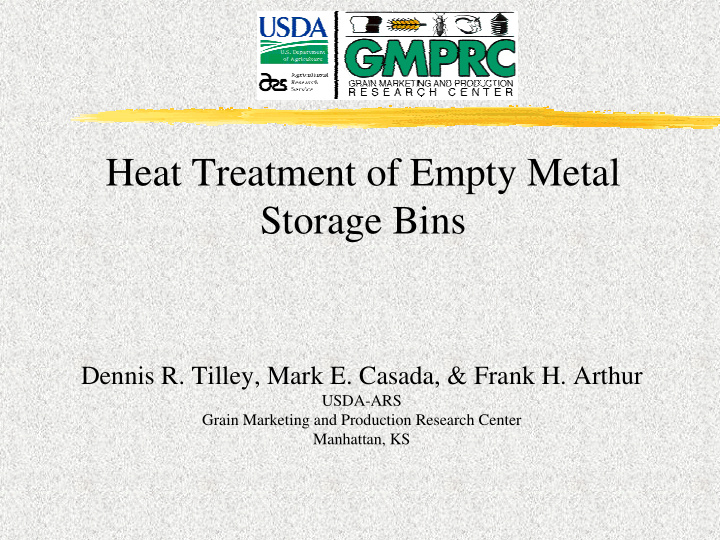



Heat Treatment of Empty Metal Storage Bins Dennis R. Tilley, Mark E. Casada, & Frank H. Arthur USDA-ARS Grain Marketing and Production Research Center Manhattan, KS
Outline * Project Overview * Objective * Equipment and Process Used * Temperatures and Insect Mortality Results * Conclusions * Future Plans
Introduction * Residual chemicals currently recommended for pre-binning sanitation * Heat treatments have been successfully applied in processing facilities to control insects (alternative to Methyl Bromide) * Bins with full drying floor particularly difficult for sanitation * GMPRC Pilot Plant had a bin needing sanitation
Project Overview *4,000 bu metal drying bin (perforated floor). *Large variable speed drying fan. *1 h.p. aeration fan for circulation in the bin. *Perforated floor was covered with tarp. *Introduced live insects to check mortality.
16 months after Before After t s a E h t r Trap Counts Trap Counts o N t s e W m o t t o t s B a E h t r o N Top t s e W 0 50 100 150 200 250 Number of Insects
Larvae Exiting Bin Larvae Exiting Bin
Project Objectives *Develop a practical method to obtain a uniform heat distribution of 120°F within the bin. *Evaluate insect mortality rates. *Develop an economic model describing the most cost effective method of using heat to sanitize steel grain bins prior to filling.
Heating Equipment Duct Heater Forced Air Propane Heaters 18 kW or 61,400 BTU 65,000 - 85,000 - 100,000 BTU
Three species added to arenas’ Three species added to arenas’ Rice weevil Red flour beetle Lesser grain borer ( Sitophilus oryzae ) ( Tribolium castaneum ) ( Rhyzopertha dominica )
Arena * 1 tsp of cracked wheat * HOBO Temperature * 3 species of insects. Instrument.
Arena Locations * 5 Control located outside of bin .. * 5 Below aeration floor * 5 Above Aeration East floor North * 7 One foot above Arena floor * 3 Upper Portions of bin South West
Electric Duct Heater Length of tests: • 12 hr • 27 hr • 40 hr South East North West Arena
Manifold and Aeration Fan Inlet of 18 kW Heater
Temperature and Time Required to Kill Temperature and Time Required to Kill 120 Time Required (Minutes) 100 Granary Weevil (all stages) 80 Rice Weevil (adults) 60 Rice Weevil 40 (larvae) Sawtoothed 20 Grain Beetle 0 120°F 140°F 160°F * Evans, D. E. 1981. The influence of some biological and physical factors on the heat tolerance relationships for R. dominica and S. oryzae. J. Stored Prod. Res. 17:656-72.
18 kW Heating Element Summary of Kill Results : 100 80 60 % Kill 40 20 0 40 Time R W 27 (hours) R F B 12 L G B Species
Heating Equipment Duct Heater Forced Air Propane Heaters 18 kW or 61,400 BTU 65,000 - 85,000 - 100,000 BTU
Propane Heat Treatment • 4,000 bu bin • Perforated floor is covered with a tarp. • Interior circulation system removed • Fuel consumption: 65 K 100 K gallons/hr 0.7 1.1 pounds/hr 3.0 4.6
Propane 100,000 BTU/hr 4 Hour Test Above Drying Floor Average Bin Temperatures 170.0 160.0 150.0 140.0 Te mp. °F 130.0 120.0 110.0 Control Bin Avg. Temperature 100.0 90.0 Ambient Temp. 80.0 70.0 0.0 0.5 1.0 1.5 2.0 2.5 3.0 3.5 4.0 Time (hr) 100 % Kill
Propane 100,000 BTU/hr 4 Hour Test Below Drying Floor Average Bin Temperatures 240.0 Center 220.0 200.0 180.0 South Temp. °F 160.0 140.0 East North 120.0 100.0 West Control Bin Avg. Temperature 80.0 Ambient Temp. 60.0 0.0 0.5 1.0 1.5 2.0 2.5 3.0 3.5 4.0 Time (hr) 100 % Kill
Conclusion * Disinfesting a steel grain bin using heat is a viable option. * Distributing heat uniformly to all parts of the concrete floor is a key for successful treatment.
Future Plans *Repeat treatments with propane heater at 65,000 BTU *Spot electric heater using recirculated air. *Controlled time motion study of sanitizing a bin by removing flooring and manually cleaning. *Development of economic model to optimize the most efficient and practical application.
Questions
Recommend
More recommend